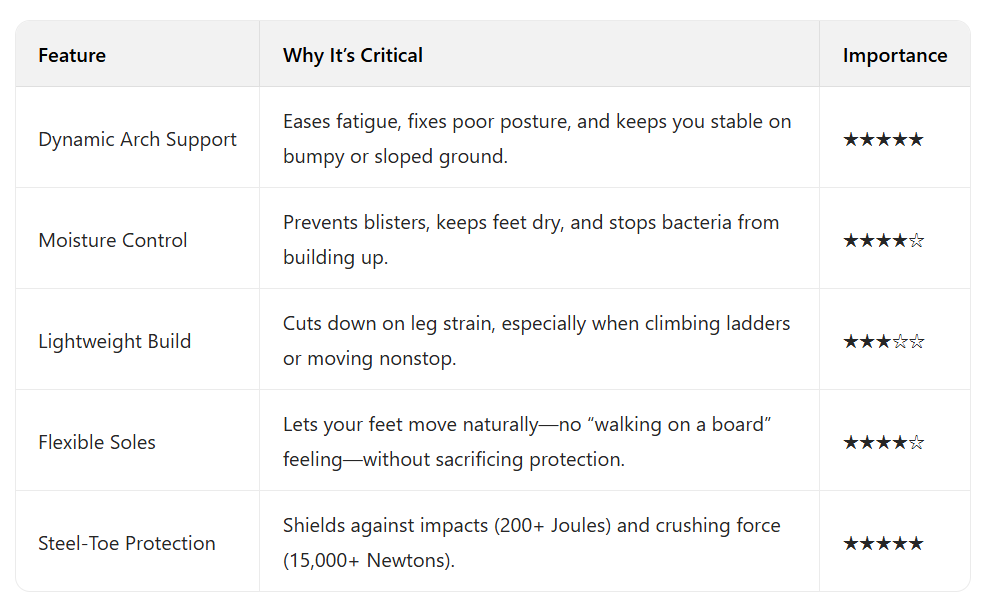If you’ve ever pulled a 10-hour shift in construction, you know that moment when you finally kick off your work boots. It’s a weird mix of relief and exhaustion—one that tells you right away if your boots were helping you, or holding you back. For years, the talk around steel-toe boots for construction has fixated on one thing: making them lighter. But here’s the truth—when you’re on your feet all day, light weight alone doesn’t solve the problem.
Don’t get me wrong: shedding a few ounces helps. Nobody wants their feet to feel like they’re dragging around cinder blocks. But if you’ve ever tried a “lightweight” safety boot that skimps on support, you know the real issue isn’t just weight—it’s how your body holds up hour after hour, step after step.
Let’s talk about what actually gets you through the day: arch support. I’ve chatted with dozens of construction folks online, and when they rave about a boot brand, it almost always comes back to this. Without solid arch support, even the lightest steel-toe boot will leave you with that deep, dull ache by lunchtime. Comfort matters, but so does stability. Good support means better balance when you’re walking on uneven concrete, carrying heavy materials, or climbing ladders. When your feet aren’t screaming, you’re more focused—and way less likely to slip up.
Then there’s the moisture-wicking lining. If you’ve ever worn boots that soak up sweat in the summer, you know it’s not just uncomfortable—it’s a real problem. Wet feet lead to blisters, irritation, and even fungal infections over time. Modern moisture-wicking linings pull sweat off your skin and let it evaporate, keeping your feet dry and cutting down on friction. This isn’t a “nice-to-have”—it’s a game-changer for anyone who wears boots from sunup to sundown.
And let’s not forget safety—because that’s non-negotiable. Steel toes exist for a reason: they stop heavy objects from crushing or slamming your feet. But the best safety boots these days don’t just check the “protective” box—they blend that protection with all-day comfort. It’s the sweet spot between a tough steel toe and smart ergonomics that makes a boot great, not just “good enough.”
What Makes a Great Steel-Toe Boot? The Key Features That Matter
Not all boots are created equal—especially when you’re relying on them for 10+ hours. Here’s how the most important features stack up, and why they matter for your day-to-day:

I remember a contractor friend of mine switched to boots with built-in arch support and a breathable lining. He said it was like going from a beat-up sedan to a truck with power steering—everything felt easier. Less fatigue, fewer breaks, and honestly? A better mood at the end of the day.
Beyond the steel toe, the materials matter too. Full-grain leather is tough and water-resistant (perfect for rainy job sites), while durable synthetic mesh keeps things breathable when it’s hot. The best outsoles use rubber composites that are puncture-proof (so nails or sharp debris won’t go through) but still flexible—no more stiff, uncomfortable steps.
How to Shop for Steel-Toe Boots (Skip the “Lightweight” Hype)
If you’re in the market for new steel-toe boots, don’t just grab the first pair labeled “lightweight.” Here’s how to pick one that actually works for your day:
- Test the arch support first: Press the arch part of the insole. It should bounce back within 3 seconds—if it stays squished, it won’t hold up. Try standing on one foot and tiptoeing; if your foot slides or wobbles, the support isn’t dynamic enough.
- Check the lining: Look for labels like “Coolmax®” or “antimicrobial.” Wipe a damp paper towel on the lining—if it dries in 30 seconds or less, it’ll handle sweat.
- Read the right reviews: Skip the “great for weekend projects” comments. Look for folks who’ve worn the boots 5+ days a week for months. Do they mention fatigue after 8 hours? How’s the sole holding up?
- Make sure it’s certified: Look for ASTM F2413 (U.S. standard) or EN ISO 20345 (EU standard) on the tag. These mean the boot actually passes safety tests—not just looks tough.
At the end of the day, a good steel-toe boot isn’t about being the lightest. It’s about working with your body: supporting your arches when you stand, keeping you dry when you sweat, and protecting you without making every step a chore. For construction workers, boots aren’t just gear—they’re your most important tool for getting through the shift. And when they fit right? Those 10 hours feel a whole lot more doable.


发表回复